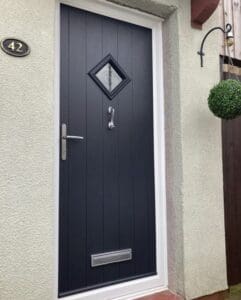Drilling a Composite Door
There are a few occasions when you might think about drilling holes into your composite door.
You might be interested in adjusting the accessories or hardware on your door, replacing the letterbox, or adding one for the first time.
Accessories and hardware that might require drill holes include door handles, locks, door knockers, letterboxes, and peepholes.

You might also want to decorate your house and door to match the season or the holiday.
This can include drilling holes into the door if you want to hang or attach something like a Christmas wreath.
If possible, you should look into other ways of attaching decorations to your door before drilling into it.
If this isn't an option, though, here you can learn more about drilling holes into your door.
What is a Composite Door?
A composite material is a material made from a combination of different materials. A composite door is made to be better and stronger than the original materials used to manufacture it.
Composite doors are typically made from insulating foam, wood, glass-reinforced plastic, and PVC.
Composite doors are popular because they give you the look of a traditional wooden door while offering all the other benefits you can get from uPVC and aluminium doors.
Unlike wood doors, composite doors don't warp, bend, crack, fade, or buckle. Typically, a composite door has layers of 2mm thick, glass-reinforced plastic on the exterior. This ensures that the door is weatherproof and won't crack.
This exterior is then fused to an internal uPVC frame. Depending on how the door was manufactured and designed, this frame might also be made from steel for added reinforcement.
The door's core is usually thick wood or an insulating foam to ensure that the door is well-insulated and sturdy.
How to Drill Holes Into a Composite Door
It can seem daunting because there are many layers of material to work through when drilling into a composite door, but it can still be done.
Attaching an accessory to your door is something you can easily do yourself, as long as you have the necessary tools.
Before you continue, you must check if drilling a hole into your door voids the warranty. Of course, if you're uncomfortable drilling a hole into your door yourself, you can always call in a professional.
Step 1
Gather all the tools you'll need to drill a hole into your door successfully.
This includes but isn't limited to, a drill, the appropriate drill bit or bits, a tape measure, a pencil, and a screwdriver. You should start with a 1mm - 2mm drill bit and see how it goes.
Step 2
Ensure you know what materials your door is made of to ensure you have the appropriate drill and drill bit to work through all the different materials.
Remember, there's glass-reinforced plastic, uPVC, wood, and maybe even steel inside your door. You may need different drill bits for the other materials that composite doors are made of.
Step 3
Depending on what you're attaching to your door, you'll want to ensure it's at the right height. If you're installing a door knocker or a peephole, you should install it at shoulder or eye level.
Of course, this is dependent on the style of door that you have. If you have glass panes in the top section of the door, you might have to go a little bit lower.
Hold the accessory against the door to see how it looks and decide on the perfect position.
Make sure you mark where you want to drill the holes first so you can ensure they're at the right level and straight. Do this by making pencil markings in the screw holes of the accessory.
When you initially start drilling, you might want to place masking tape on the door's surface to avoid the drill bit sliding around on the glass-reinforced plastic surface. Make the pencil marks on the masking tape so you still know where you intend to drill.
If you don't want to use masking tape, you can try to use a tool to centre-punch the door. This leaves a noticeable dent to guide you when drilling.
Step 4
Ascertain whether the accessory has surface mount fixing or through-the-door fixing.
Surface mount fixing means that the accessory is fixed to the front of the door with screws, while through-the-door fixing uses bolts and requires you to drill a hole through the door.
Step 5
For a surface mount fixing:
Drill two small pilot holes into the door, ensuring you don't drill all through. These two holes are to ensure that the screws don't damage the door and go in quickly.
For a through-the-door fixing:
Drill two small pilot holes into the door until you see the drill bit emerge on the other end.
Go to the other side of the door and enlarge the holes by drilling into them from this side as well. This minimises the amount of damage to the door from the drill bit exiting.
Step 6
For a surface mount fixing:
Place your accessory in the chosen position and then insert and tighten the screws. It's that easy! Now, you should have a new door knocker or accessory on your door with little to no hassle.
For a through-the-door fixing:
Clean your drill holes to ensure there are no debris or wood shavings before you continue. Then, place your accessory against the door in the chosen position.
Insert each bolt, one at a time, and secure them from the other side to ensure your accessory is securely mounted.

Why Choose Us?
Our composite doors are secure and weatherproof due to our TriSeal frame and a highly advanced, multi-latch deadbolt auto-lock locking system.
Our locks feature a 3-star rated ABS cylinder; all our hardware is stainless steel. Our energy-efficient composite doors boast a low energy rating of 1.4 W/m² u-Value.
We offer composite doors in over 250 InvisiEdge colour combinations with chamfered or sculptured frames.
The InvisiEdge system ensures a seamless edge to the door while keeping out 100% of moisture.
Get the look and feel of a traditional wooden door with all the energy efficiency of a uPVC door and more.
You can custom design your door so that it has all the necessary accessories beforehand with no extra work on your part or risk of voiding the warranty or damaging the door.
We have the right door for you, no matter what look or style you're in the market for! Find more tips on maintaining and choosing composite doors on our blog.









